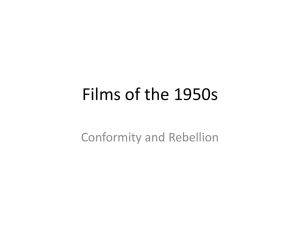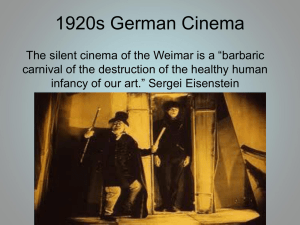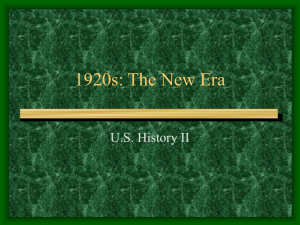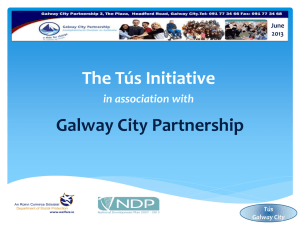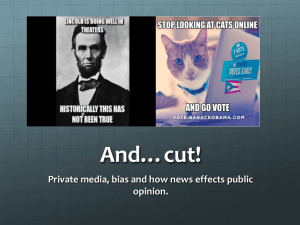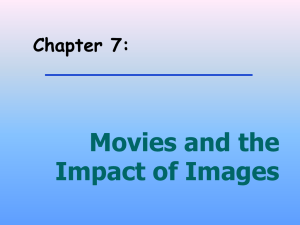Pay TV in France – 10 years of decisional practice
advertisement
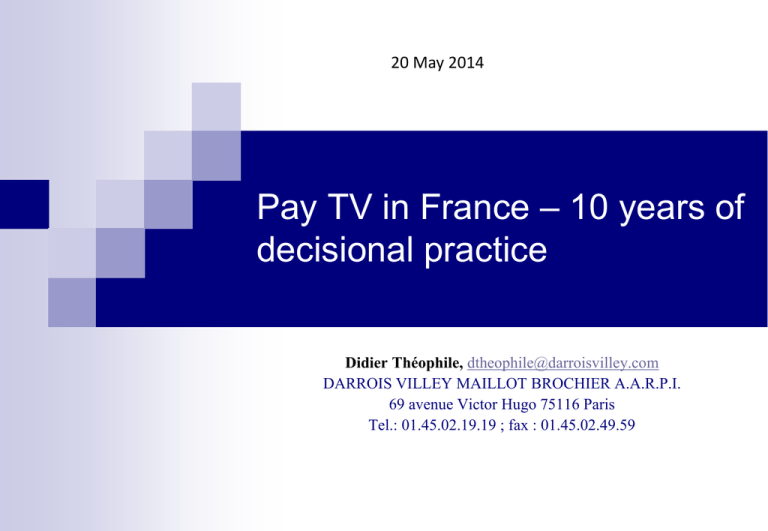
20 May 2014 Pay TV in France – 10 years of decisional practice Didier Théophile, dtheophile@darroisvilley.com DARROIS VILLEY MAILLOT BROCHIER A.A.R.P.I. 69 avenue Victor Hugo 75116 Paris Tel.: 01.45.02.19.19 ; fax : 01.45.02.49.59 Plan of the presentation Presentation of the actors and competitive environment at all levels of the pay-TV value chain. Analysis of the French Competition Authority’s (« FCA ») decisional practice in the French pay-TV sector. Discussion regarding the FCA’s success in guaranteeing effective competition in the pay-TV sector. 2 Presentation of the actors and competitive environment at all levels of the pay-TV value chain (1/5) Upstream level : acquisition of audio-visual content Film rights Group Canal Plus (« GCP ») is the dominant player on the market for the acquisition of film rights (approximately 90% market share). Orange entered the market in 2008. However, the competitive pressure exerted by Orange on GCP was temporary and limited due mostly to a change in Orange’s business strategy. Rights to sporting events GCP is the market leader on the market for the acquisition of rights to football matches. GCP’s market share has decreased due to: Orange’s entry onto the market, although it has exited the market having suffered great financial loss. Al Jazeera’s entry onto the market and purchase of attractive football events which it broadcasts on two channels (BeIn 1 and BeIn2). 3 Presentation of the actors and competitive environment at all levels of the pay-TV value chain (2/5) The competitive pressure exerted on GCP on the upstream market by non-linear television operators, such as VOD, is weak due to the following regulatory constraints : Strict media chronology for movies Contribution to the development and production of French cinema VOD : 4 to 10 months after film release. Pay-TV : first window between 10 or 12 months and 22 months after film release. Free-TV : first window between 22 or 30 (depending on co-production agreements) and 36 months after film release. SVOD: 36 months after film release. Financial contribution Exposition quotas Netflix The leading SVOD provider has announced it would enter the French market in the fall, most likely via Luxembourg in order to avoid French media chronology and financial contribution obligations. 4 Presentation of the actors and competitive environment at all levels of the pay-TV value chain (3/5) Intermediary level: the edition and marketing of pay-TV channels: The edition of premium channels The edition of cinema channels GCP is the only editor of a premium pay-TV channel in France. Cinema channel editors are CGP, Orange (5 channels), AB (3 channels) and Disney. The edition of sports channels “Premium” sports channels: Other sports channels GCP is the leading premium sports channel editor with Canal + and its derivative, Canal + Sport. Al Jazeera edits two premium sports channels (BeIn 1 and BeIn 2). GCP edits Sport +. TF1 currently edits two pay-TV sports channels, Eurosport and Eurosport 2, which are in the process of being sold to Discovery. The edition of other pay-TV channels TF1, the leading free-TV group, edits eight pay-TV channels. Out of these eights, one has issued a request to be broadcast on free-TV (LCI), one is expected to close by Dec, 2014 (TF6, held jointly by TF1 and M6) and two are in the process of being sold (Eurosport and Eurosport 2). AB Sat is the principal French editors of non-premium independent thematic pay-TV channels. Other international pay-TV channel editors are Universal, Fox and MTV. 5 Presentation of the actors and competitive environment at all levels of the Pay-TV value chain (4/5) Downstream level : retail distribution of pay-TV services Actors GCP is the dominant player on the market for retail distribution of pay-TV services (approx. 90%). GCP auto-distributes its CanalSat package on all types of broadcasting modes (satellite, DSL, high speed fiber and pay-DTT), except for the cable. Auto-distribution : IAPs only transport GCP’s package, CanalSat. GCP controls the subscriptions and the service to end customers. CanalSat is not distributed as a package on the cable. Because of historic reasons Numericable benefits from direct access, on the wholesale market, to thematic channels which its distributes in its own packages (this does not apply to Canal +, GCP’s premium channel and its derivatives). Numericable: controls the cable, the historic distribution mode of pay-TV in France Internet Access Providers (« IAP »): only the « second level » packages compete with GCP’s high end offer. IAPs own first level packages do not exert competitive pressure on GCP’s pay-TV package, CanalSat. These packages do not contain premium channels or cinema channels. As such, they are not substitutable to CanalSat. The increase of DSL subscribers results from the popularity of “triple play” offers rather than the attractiveness of the IAP’s first level television offer. 6 Presentation of the actors and competitive environment at all levels of the pay-TV value chain (5/5) Downstream level : retail distribution of pay-TV services Market dynamics Distribution exclusivity: GCP’s market position can partly be explained by the bonus which GCP awards channel editors in return for distribution exclusivity. Lack of incentive on the part of IAPs to develop their own packages: GCP’s packages are available on IAP’s platforms. Consequence of the SFR/Numericable merger: Following the Numericable/SFR merger, SFR will be able to package CanalSat’s channels independently from GCP. This will reinforce the new entity’s position on the «3P» market. 7 Analysis of the FCA’s merger control practice in the French Pay-TV sector The entry of Vivendi on the market for DSL distribution of pay-TV (SFR / Tele 2 (2007) and SFR/Neuf Cegetel ( 2008)) Vivendi is the holding company of both SFR and GCP. Competition concerns Tele 2 and Neuf Cegetel’s position as DSL providers would be substantially reinforced as a consequence of benefiting from a privileged access to audiovisual content held by Vivendi, GCP’s holding company. Following the transaction, Vivendi would have the incentive to reinforce the packages owned by Tele 2 and Neuf Cegetel. Remedies Preventing discrimination between DSL operators: the parties committed to guarantee equal treatment between Tele 2 and all other DSL providers. Maintaining IAPs capacity to compete effectively on the market for pay-TV: the parties granted unbundled access to two thematic channels. Remedying the disappearance of a pay-TV distributor: the parties made the Neuf Cegetel platform available to a third party distributor. However, in practice, no third party distributor was interested in the Neuf Cegetel platform. 8 The CanalSat/TPS saga (2006) - Competition concerns TPS was GCP’s competing pay-TV platform, present at all levels of the pay-TV value chain. Upstream market The merger created a quasi-monopsony in the market for both American and French films. Entry was unlikely due to (i) the necessity for a potential competitor to enter simultaneously into the editing market and, in France, (ii) the particular financing system in France, the prepurchasing agreements, which leads GCP to pre-empt the rights to the most attractive French movies. Focus on the French pre-purchase system GCP’s premium channel, Canal +, cinema services, Ciné + and free-to-air channels all have to invest a certain amount of their annual revenue to film production. This investment obligation takes the form of the pre-purchase of broadcasting rights: Canal +: 12.5% for European films, 9.5% for French films. Ciné +: 27% for European films, 25% for French films. Free-to-air channels: 3.2% if they broadcast > 52 films per year. In return for their financial participation, pay-TV channels may pre-purchase the first and/or second broadcasting windows. In France, almost all films which are broadcasted on television are pre-financed by GCP. Free-to-air channels provide supplementary financing only. GCP has turned a legal obligation into a competitive advantage: In 2012, GCP’s investment represented 91% of all pre-purchasing investments. GCP’s pre-purchases rights for both first and second window broadcasts. 9 The CanalSat/TPS saga (2006) - Competition concerns Intermediary market The merger created a monopoly in the market for the edition and marketing of premium channels. Entry was unlikely considering (i) alternative pay-TV distributors did not express a desire to enter the editing market, (ii) the cost of purchasing premium content and (iii) the know-how required to edit a premium channel. Downstream market Following the merger, Vivendi operated the only two existing satellite platforms and enjoyed a significant presence on alternative broadcasting channels. The competitive pressure exerted by DSL operators was not sufficient to counterbalance the anticompetitive effect of the merger, mainly as a result of their reliance on GCP’s package 10 The CanalSat/TPS saga (2006) – Remedies Twofold aim Upstream level Limit GCP’s market power at all levels of the value chain ; and stimulate competition on the downstream market by granting access to a certain number of channels viewed as necessary for GCP’s competitors to market an attractive pay-TV package. Facilitate the acquisition of rights to content. E.g.: limiting the duration of framework contracts with American major studios. Intermediary level Grant to GCP’s competitors access to thematic channels necessary to market a pay-TV package. E.g.: make available and guarantee the quality of seven channels: TPS Star (premium channel), Cinéstar, Cinécult and Cinétoile (cinema channels), Sport + and Piwi and Telétoon (youth channels). 11 The CanalSat/TPS saga (2011) – annulment The FCA found that GCP had not complied with several commitments attached to the 2006 authorization decision. In particular, GCP failed to comply with commitments which aimed at creating a wholesale market for thematic channels by purposefully downgrading the quality of the channels to which it had committed to give access to third pay-TV distributors: The quality of the films, sporting events and series had been downgraded. Lack of technical innovation. Decline in the number of subscribers. As a result, the FCA withdrew the 2006 authorization decision and fined GCP EUR 30 millions. 12 The CanalSat/TPS saga (2012) – second authorization decision The pursuit of identical objectives: Stimulating downstream competition by giving IAPs access to a wholesale market of popular pay-TV channels. Enabling the creation of new pay-TV packages which - as a consequence of being less attractive - would also be less costly and therefore more accessible to customers. Injunctions The FCA enjoined GCP to give access, on an unbundled basis, to all the cinema channels GCP edits for its own package, CanalSat. The FCA also enjoined GCP to divest itself of its participation in Orange’s payTV packages. In April 2012, GCP and Orange concluded an agreed by which GCP acquired one third of Orange Cinema Series (“OCS”), Orange’s editing entity. The agreement was analyzed by the European Commission as conferring joint control to GCP and Orange over OCS. GCP’s favorable vote was necessary for investments over a certain amount. As a consequence, i) Orange’s position on the upstream market for the acquisition of rights was considerably weakened and ii) Orange could no longer be considered as an independent competitor. 12 GCP / Direct 7 / Direct Star (2012) : authorization of the acquisition by GCP of two free-to-air channels Context: Competition concerns : entry of the dominant pay-TV operator into free-TV at a time where GCP’s subscriptions are decreasing and free-DTT channels have an important audience potential. Leverage by GCP of its strong position on the market for the acquisition of content for payTV to confer Direct 7 and Direct Star a privileged access to attractive and popular free-TV content. GCP is likely to leverage its strong market position on the market for the acquisition of content for pay-TV into the market for the acquisition of French and American films and series for free-TV. Identical interlocutors within the Hollywood studios are in charge of negotiating broadcasting rights for films and series on pay -TV and free-TV. The bundled purchase of these rights is common practice. It is highly unlikely that free-TV channels would invest in the pay-TV sector in order to replicate GCP’s competitive advantage. GCP has the incentive to leverage its position GCP had publicly announced that it wished to reinforce Direct 8 and Direct Star’s programs with more films and series. Note: following the merger, D8’s market share increased from 2.3% to 3.2% in one year. On the television advertising market, it increased from approx. 2% to 3%. 14 GCP / Direct 7 / Direct Star (2012) : authorization of the acquisition by GCP of two free-to-air channels Remedies Acquisition of broadcasting rights for American films and series: the parties committed not to enter into a framework contract with more than one major studio by which it would purchase bundled broadcasting rights for films or recent series on both pay-TV and on free-TV. Acquisition of broadcasting rights for French films: the parties committed not to purchase bundled broadcasting rights on pay-TV and on the free-toair TV for more than 20 films. Separate negotiation teams: the parties committed to have one team in charge of purchasing content for pay-TV and a separate team in charge of purchasing rights for free-TV. 15 GCP / Direct 7 / Direct Star (2013) – annulment The authorization decision was annulled by the Conseil d’Etat, the highest administrative court in France on procedural grounds. The Conseil d’Etat also considered that the FCA had made an error of assessment by accepting remedies aimed at preventing the foreclosure of rebroadcasting rights of French films on free-TV. According to commitment 2.2, parties could not purchase bundled broadcasting rights on pay-TV and on the free-to-air TV for more than 20 French films. However, the Conseil d’Etat noted that film right holders also sell, at the pre-financing stage, rights to the second and third broadcasting windows on free-TV. Therefore, following the merger, nothing prevented GCP from purchasing bundled pay-TV rights and second and third broadcasting windows on free-TV. This would negatively impact new free-DTT channels as second and third broadcasting windows are cheaper to buy than the first and generate high audience levels. GCP / Direct 7 / Direct Star (2013) – second authorization decision The competition concerns analyzed by the FCA were identical to those analyzed in the first decision: conglomerate effects resulting from GCP leveraging its position on the pay-tv market into the market for the acquisition of free-TV rights. 16 GCP / Direct 7 / Direct Star (2013) –competition concerns and reinforced commitments Competition concerns Television groups maximize the number of broadcasting windows they pre-purchase for a same movie on their different channels in order to amortize their global investment. Should GCP leverage its position on the pay-TV market into the market for the purchase of second and third free-TV windows, other free-TV channels would not be able to amortize the purchase of the first broadcasting window. This would limit free-TV channels’ capacity to invest into attractive content. Should GCP pre-empt the free-TV broadcasting windows for French films, free-to-air channels could not shift their purchase from French films to American films due to their investment obligations. Therefore, free-TV channels would have to buy less attractive content. Reinforced commitments The parties submitted new commitments which aimed at preventing anticompetitive effects on the market for rebroadcasting rights of French films on the second and third free-TV windows. The parties therefore committed not to pre-purchase the broadcasting rights on free-TV and pay-TV for more than 20 French films. As pre-purchasing may occur on any window, this commitment remedies the risk that GCP 17 would pre-empt the second and third windows for free-TV broadcasting. Analysis of the FCA’s anticompetitive practices decision in the French pay-TV sector GCP’s exclusivity practices called into question by the FCA in its 2010 decision: those concerning the distribution of channels edited by GCP ; those concerning the distribution via high-speed Internet and “catch-up television” of “linked channels” ; those concerning the distribution of independent channels. The FCA concluded that it did not dispose of sufficient information to conclude on the existence or absence of anticompetitive effects resulting from these practices. As a result, the inquiry into GCP’s exclusivity practices is still underway. The FCA also examined, and rejected, claims pertaining to : defamation by GCP of France Telecom – Orange ; bundling of GCP’s package CanalSat and premium mini-package Canal+ le Bouquet ; and discriminatory pricing policy against the AB Group. 18 Conclusion The success of the FCA’s objective – stimulating competition downstream – was dependent on IAPs marketing their own competitive second level packages to end customers. Although the FCA gave IAPs the means to achieve this goal - by, inter alia, giving them access to attractive cinema channels – this goal has not been reached. IAPs still haven’t made a significant entry into the market for the retail distribution of pay-TV services, excluding their first level offers. This trend may change following the Numericable/SFR merger, whereby SFR will be able to package CanalSat’s channels independently from GCP. This will reinforce the new entity’s position on the «3P» market. 19

